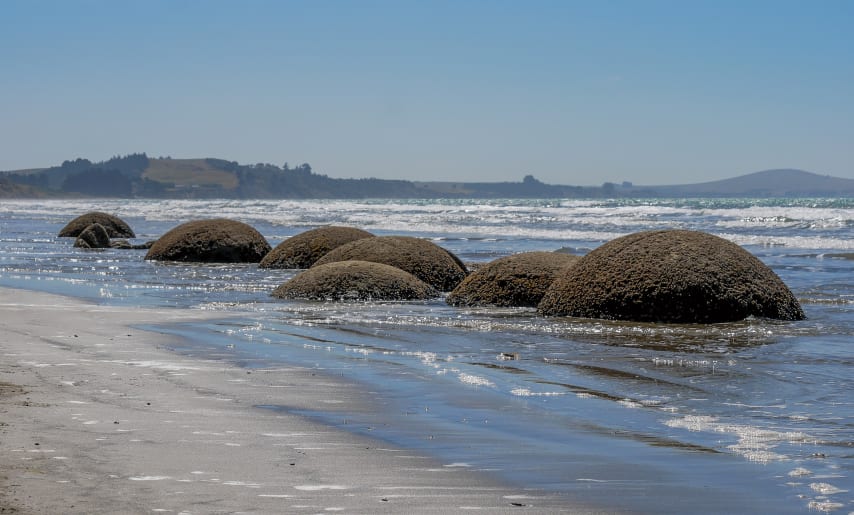Missing the chance to feast at Moeraki’s now-closed Fleur’s Place, Jo Ferris at least knew the famed boulders would be there in all their glory – only to discover they didn’t quite live up to expectations.
This small South Island fishing village has always held appeal as a “must do” destination. Fleur’s Place might have immortalised its international renown before finally closing in 2021, but the Moeraki Boulders/Kaihinaki have drawn far more people over generations, fascinated by their scientific mysticism and Māori mythology.
Māori legend has the boulders as relics of a shipwrecked waka, Araiteuru, at Shag Point ((Matakaea) further south. The ensuing flotsam saw gourds, kūmara and eel baskets washed ashore which, over time, formed the large boulders seen today.
Romantic as that may sound, scientific evidence dates the boulders back some 65 million years, each starting life as a pebble or fossil on the seabed. Over time, thanks to mud accretion and calcification, huge boulders were formed. Initially buried deep in mud, erosion and the sea slowly unearthed them and seemingly scattered them along the foreshore. Current erosion on the banks at Koekohe Beach is revealing more boulders, while the elements wreak disruption on existing boulders on the beach, causing them to crack and break down.
They have been photographed by countless visitors and professionals capturing strategic sunrise backdrops during seasonal changes. Images in magazines, on postcards and the internet are far more spectacular than I could ever have achieved. Wrong season for starters. Also, the boulders that greeted me didn’t quite live up to expectations. There seemed fewer and most were buried to the point they only showed half their considerable circumference. Only two, up by the bank, revealed their vast size and undoubted weight.
Thanks to this beach’s easy access — a five to 10-minute walk from the carpark at the café above — people come in droves to see the boulders. They stand on them, leap from one to the other, or simply gaze at their intriguing formations. It can be hard to get a shot of the boulders in their solidarity — patience is a fine asset.
While most show their circular shape, others have marbled cracks and splits that reveal an inner kernel that bears a squint-eyed resemblance to a marzipan ball. Eternally fascinating, it’s easy to see why these boulders have been prey for souvenir hunters in the past. Some have been moved, others vandalised, even turned into cement. An audacious plan in the ‘70s sought to move some closer to a car park by the beach to make them accessible to more people. Earlier reports even suggested that moving the boulders would save them from being broken up by the sea and lost forever.
One of the largest was removed back in the 1930s and placed outside Otago Museum. Some have ended up in gardens and towns up and down the Otago and Canterbury coastline — even as far as Australia. With many more boulders accounted for in earlier years, only about 50 remain on the beach today.
A Stuff article in 2021 noted that some smaller boulders have been returned, both to the local marae and the southern end of Kātiki Beach, south of Moeraki. They are protected under the Reserves Act 1977 and a Department of Conservation sign at Koekohe Beach outlines the strong penalties for wilful damage. Removal of any part is strictly verboten.
What is left of these odd but mysteriously beautiful quirks of nature are a reminder of how we are just a speck on the wallpaper of life as mankind journeys through nature’s own transition — hopefully grateful and looking after nature, not destroying it.
The boulders are integral to Moeraki’s lure as a place to laze the days away in this quaint fishing village. Another local attraction is the nature walk by the lighthouse at Kātiki Point, a cliff-top trail that weaves above rocky beaches where sea lions bask in the sun or check out people peering down at them.
If you’re lucky — extremely lucky like I was — you might even see a rare yellow-eyed penguin. Usually seen at dusk when they come ashore, this chap stood in broad daylight, flippers outstretched, a few feet below the fenced trail and blissfully uncaring of the gathering crowd. For a brief second, thoughts of a wind-up model popped into mind. How could this creature not know the time of day? Yet there he was — magnificent. Posing.
Interaction with wildlife is one of life’s true joys and yet another reminder of how fragile nature and its inhabitants are as humanity continues to ruin it for these gentle creatures of the sea and land. We should be humbled and do more to preserve what nature has given us. Look after it, before all is lost. As the timeless warning states: take nothing but photos, leave only footprints.
What to see
Moeraki Boulders/Kaihinaki
Lighthouse walk to Kātiki Point
Moeraki Memorial Walk to Koekohe Beach
Where to stay
Moeraki Beach Motel
Where to eat
Moeraki Café, Bar and Gift Shop
Moeraki Tavern
The Fishwife













